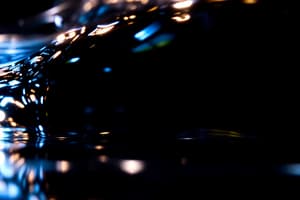Podcast
Questions and Answers
What is the major application of reflection in reflective telescopes?
What is the major application of reflection in reflective telescopes?
Collecting more light by redirecting incoming photons towards a detector
How does the shiny finish of sports equipment like tennis rackets aid in performance?
How does the shiny finish of sports equipment like tennis rackets aid in performance?
It reduces friction between the surface and air, allowing the object to travel farther
In what way does reflection contribute to security systems like surveillance cameras?
In what way does reflection contribute to security systems like surveillance cameras?
Mirrored surfaces create blind spots so people cannot see themselves being filmed
Why does refraction occur when light moves into different materials?
Why does refraction occur when light moves into different materials?
How are optical fibers utilized in telecommunications networks?
How are optical fibers utilized in telecommunications networks?
Flashcards are hidden until you start studying
Study Notes
Light is essential in our daily lives, from seeing what's around us to making devices work efficiently. When light interacts with objects, it can reflect off them (a type of scattering) or pass through them, bending its direction in the process – this phenomenon is known as refraction. In this article, we will explore some common applications of both light reflection and refraction, which have numerous practical uses across various fields.
Reflection occurs when the angle of incidence equals the angle of reflection; light waves bounce back without changing their speed. One major application of reflection involves mirrors used in reflective telescopes, where they help collect more light by redirecting incoming photons towards a detector. Another example is the shiny finish of many sports equipment like tennis rackets, golf clubs, and baseball bats, which reduces friction between the surface and air, allowing the object to travel farther. Reflection also plays a role in security systems like surveillance cameras, where mirrored surfaces create blind spots so people cannot see themselves being filmed.
Refraction occurs because light slows down as it moves into different materials, causing it to change direction. It is commonly seen when water meets land or parts of buildings are protected with plastic sheeting. Refraction has several important applications too. Optical fibers rely heavily on refracted light to transmit signals over vast distances through telecommunications networks. Thin lenses focus light rays onto small areas, enabling clear images on screens and projectors. Solar panels comprise tightly arranged silicon cells that absorb sunlight and convert it into electricity due to the difference in energy levels within these cells.
In summary, understanding how light reflects and refracts is crucial because it underlies nearly all light-based technologies such as optics, photography, filmmaking, security systems, solar power generation, and even navigation tools utilizing radar signal travel times. These principles guide researchers developing groundbreaking advancements in science each day!
Studying That Suits You
Use AI to generate personalized quizzes and flashcards to suit your learning preferences.




